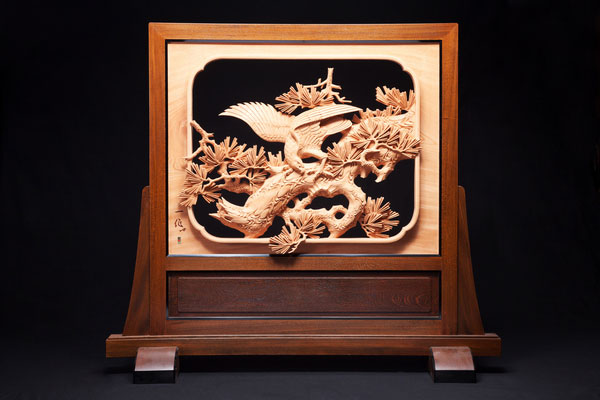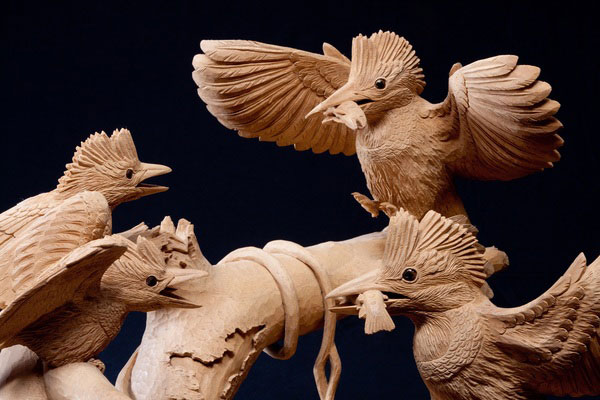
- Wood, bamboo crafts
- Toyama
Inami wood carvings Inami chokoku
Traditional woodcarvings of wonder and splendor
From carpenters to carvers of celestial beings
Description
What is Inami wood carvings ?
Inami woodcarvings (called Inami chokoku in Japanese) are produced in the city of Nanto, Toyama prefecture mainly in the form of transoms*, decorative objects, and single-leaf screens**. They are usually made of Japanese camphor, paulownia, or zelkova wood, and carved with landscapes, flowers and birds, human figures, animals or dragons. Inami woodcarvings are distinguished by the exceptional woodcarving abilities of three-dimensional works filled with life and movement. Experienced artisans use over two hundred different chisels and knives to carve both sides of a work, a technique known as sukashi-fukabori, which amply demonstrates their superb craftsmanship. For example, in the carving of a transom between rooms, the artisan takes into account the gaze of a person looking up from below, and ensures that the many layers create depth in the work. In addition, these elaborate carving techniques create shadow, giving great expressiveness so that when one looks at a dragon, it is as if at any moment it will fly free. In recent years, a large amount of Inami woodcarvers have combined their dragon or lion motifs with the electric guitar or bass, showing that the traditional craft is continuously taking on new challenges. Since 1991, Japan's largest woodcarving event, the Inami International Wooden Sculpture Camp has been held in the city of Nanto and regularly invites woodcarvers from twelve different countries, leading to international cultural exchange.
*A transom is a horizontal beam that separates a door from a window or fanlight above it.
**A single leaf screen is an independently standing partition-screen with one panel.
History

Inami is the former name of the city of Nanto in Toyama prefecture. The origins of Inami woodcarving can be traced back to the 1750s. The area already had a number of highly-skilled carpenters, but woodcarving only properly began during the rebuilding of the main worship hall at Zuisen-ji Temple in Inami, when Sanshiro MAEKAWA, an official patronage woodcarver of Kyoto Hongan-ji Temple arrived to take up work. Local carpenters, including Shichizaemon IX, worked under Maekawa and he passed on his carving techniques.
In 1792, at Zuisen-ji Temple, Shichizaemon IX carved the Chrysanthemum Doors of the Chokushi-mon (the gate for imperial envoys) and the Shishi no Ko Otoshi (lion posts located to each side). These works are his representative works and they are praised as Japanese woodcarving masterpieces. During the Edo period (1603-1868), carpenters also earned their living from woodcarving but the majority of such work was for temples. In the Meiji period (1868-1912), because of their great skills and artistic abilities, many of them left carpentry to become specialist woodcarvers. The type of work also expanded from temple carvings to decorative transoms in private houses to a much wider appreciation of the craft in society. In 1914, Goun OSHIMA submitted his piece Transom for a Library to the Panama–Pacific International Exposition held in San Francisco, 1915 and won an honorary gold prize. By this period, Inami woodcarving artisans were training many apprentices and significantly increasing their numbers. In 1947, a training school was established and the techniques have been passed down to the present day.
General Production Process

- 1. Drawing the design
Domestically lumbered camphor, paulownia, or zelkova timber is selected according to the final product. If the timber still has a high water content, it is left to dry naturally for six months to a year before cutting to size. The work design is drawn with charcoal on washi (traditional Japanese paper), and then transferred onto the wood. If the design were directly drawn on the wood, the lines would disappear during carving; hence the design is made as a transfer.
- 2. Opening
Based on the transferred design, a fretsaw (saw with a narrow blade stretched vertically on a frame) is used to roughly cut out the unnecessary parts.
- 3. Rough shaping
Around fifteen different rough shaving chisels, a hammer, and knives are used to shape and create the outline of the work. When the outline is completed, the piece is again naturally dried for about one month.
- 4. Rough carving
As many as seventy different types of chisels are used to deeply carve the entire design and give more surface shape to the piece. The artisan may use about two hundred fine rough carving chisels to bring the image they have in their mind out of the wood. Inami woodcarving is three-dimensional openwork carved from both sides; therefore, rough and fine carving is repeated on the reverse side as well. The work piece is turned over and the undersurface is reflected in a mirror. Through the fret-sawn openings, the upper surface is carved while being checked that there is no misalignment between the two sides.
- 5. Finishing carving
Although the basic outline and detailed shapes have now been carved, the surfaces are still rough, uneven, and in need of smoothing. No sandpaper is ever used; rather several small and large finishing chisels and a small hand plane are used to smooth and sharpen up the final shape and finer details. After applying any coloring and decoration, the whole piece is thoroughly inspected and any minor adjustments are made before completion.
Where to Buy & More Information
Inami-Chokoku Sogo Kaikan
-
Address
-
Tel.+81-763-82-5158
-
Closed2nd and 4th Wednesday of the month, around the New Year
-
Business Hours9am to 5pm
-
Website
See more Wood, bamboo crafts
- Hakone wood mosaic
- Iwayado traditional chest
- Kaba cherrybark woodcrafts
- Odate bentwood
- Inami wood carvings
- Matsumoto furniture
- Beppu bamboo crafts
- Edo wood joinery
- Ichii woodcarvings
- Suruga bamboo crafts
- Edo bamboo fishing rods
- Kishu bamboo fishing rods
- Kamo traditional chest
- Kyo wood joinery
- Miyakonojo archery bows
- Osaka carved wooden panel
- Miyajima woodwork
- Nibutani carved wooden tray
- Okuaizu Basketry
- Echizen traditional chest
- Kasukabe traditional paulownia chest
- Katsuyama bamboo crafts
- Osaka karaki wood joinery
- Takayama tea whisks
- Toyooka wicker crafts
- Akita cedar tubs and barrels
- Nagiso woodturning
- Kishu traditional chest
- Nagoya traditional paulownia chest
- Osaka bamboo screens
- Osaka-senshu traditional paulownia chest
- Sendai traditional chest































































































































































































































































































